You may recall that Alina Bradford wrote a guest post on WriteWorldwide titled: The Ultimate Guide to Finding Writing Jobs: 7 Creative Ways. If you don’t, I urge you to check it out as there are many nuggets of information that will help you land your next lucrative writing gig.
In fact, I recently used one of the techniques to diversify my client base by landing a writing project worth $4,000. Read on to learn more.
That Moment You Realise You Have a Problem
A few months ago, I took a long hard look at my business and discovered there was one MASSIVE problem: The majority of my income was coming from only one client. And when I say the majority, I’m talking about a revenue concentration of over 80%.
Now that’s a precarious predicament for any writer. You only have to lose that client to watch your income take a huge hit. Indeed, as you may recall this is precisely what happened to my friend Ciaran.
After Ciaran’s client decided they no longer had the budget for his services, he was in a flat spin about what to do. Thankfully, Ciaran has since managed to replace a portion of that income – you can read about that here.
Now, what happened to Ciaran could happen to anyone. The good news is that you can protect yourself from these situations rearing their ugly heads by marketing yourself constantly to diversify your client base.
LinkedIn to the Rescue
Understanding the importance of having a diverse client base in my own business, I began looking for ways to get more clients. That’s when I remembered Alina’s post. I headed over to it and worked my way down the list of methods she suggests for finding clients.
I hit up social media and typed some keywords into Google, before spending some time on LinkedIn. I have used LinkedIn to great effect in the past when building a prospect list and finding clients, but now decided to try something different: I searched for job posts on LinkedIn by typing keywords into the search bar.
I did so tentatively, not really expecting results. I visited my LinkedIn home page and typed the keywords: “Looking for freelance writer” or “looking for writer.” I also followed Alina’s suggestions by:
- Choosing content in the options menu at the top left
- Sorting by “latest” content – you don’t want to be searching for postings from months ago.

I also got more specific and typed in “looking for a B2B writer” (yes that’s my niche, and I’m no longer a generalist). Before I continue, I’d like to give you a pointer: If you also choose to get that specific and search for jobs in your niche, you may want to ignore the advice about sorting by the “latest”, and instead, sort by “relevance”.
To show you what I mean, compare these two results:
After typing in “Looking for B2B writer” and sorting by latest content, I get this:

But by sorting by relevance, I get this:

Big difference, right? The second screenshot clearly shows a job posting for a B2B writer while the first doesn’t. So, experiment with this and try and nail the sweet spot: Relevant recent postings.
Ok, now back to my process. After finding several job postings that interested me, I started responding. All in all, I responded to a total of seven. While my responses varied depending on the post, I always included a follow-up connection request and added a personal note mentioning that I had responded to their post.
Below are three examples of responses:
Example 1:
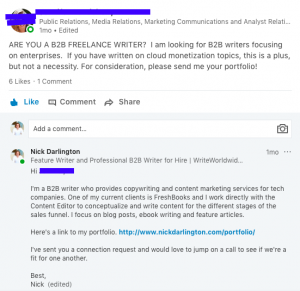
Example 2:
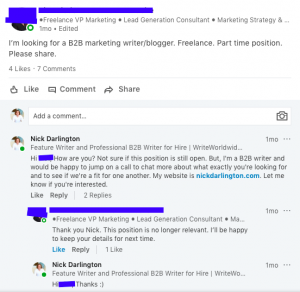
Example 3:
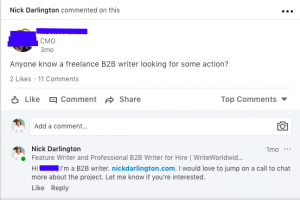
I got no responses with some postings and with others I was told that the position had been filled. Funnily enough, it was the last example with the shortest comment that got a positive response: Only a few days later I received an email from that client.
The Promising Client Call
He had visited my site, filled out my contact form, and I followed up insisting that we jump on a Google Hangouts call to see if we were a fit for one another.
I highly recommend writers do this as it allows you to create a personal connection with the prospect, learn more about their business, and see if you’re comfortable working with them.
During the client call, I followed my own advice about being prepared and remaining confident on client calls – something I recently wrote about on WW. By the end of what was a very informative and promising call, we had agreed on the next steps.
He was to send me to a very rough outline for two pillar pages he wanted me to write. I would then have a look and send through a cost estimate.
To cut a long story short, I sent through a cost estimate of €3,450 (or $4,000) for the entire project:
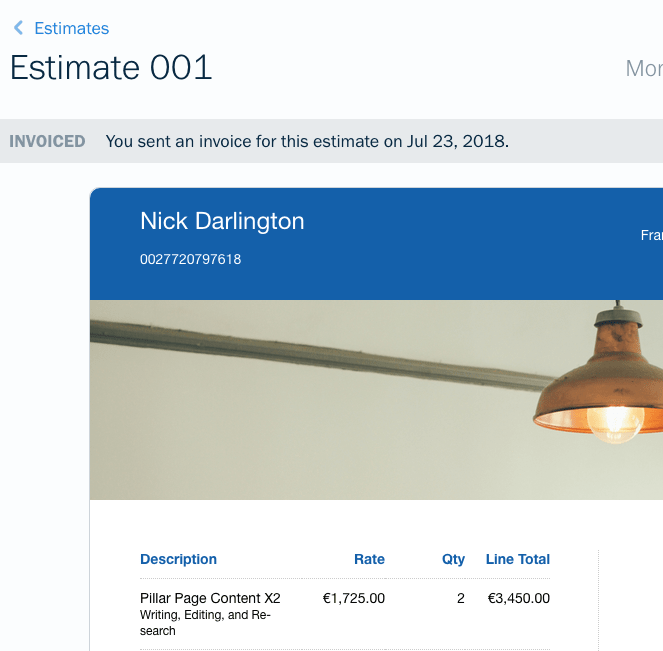
But how had I decided on that number? And, would the client go for it?
The Power of Value-Based Pricing
To address the first question, I went over the outline, added a few notes of my own and assessed how much work this would involve. More importantly, I determined the value of two well-written pillar pages.
This is a lesson I’ve learned over the past year: Quote on the value, not the number of words, or how long a project takes. Both “time” and “words” have their drawbacks, something we discuss in detail in our Freelance Writer’s Pricing Guide.
To understand the value of this project I did my research on Pillar pages: What they are and their benefits.
What Are Pillar Pages
With pillar pages, you select a broad content topic and create long-form content that links out to various individual topic clusters or blog posts. The pillar page will cover all details about the topic broadly and link out to more detailed blog posts. It’s usually housed on a separate page from your blog.
Hubspot’s definition and explanation is a good one: “Pillar pages broadly cover a particular topic, and cluster content should address a specific keyword related to that topic in-depth. For example, you might write a pillar page about content marketing — a broad topic — and a piece of cluster content about blogging — a more specific keyword within the topic.”
What Are the Benefits of Pillar Pages
Now for the value:
- Pillar pages help clients organise their content better, especially clients who have large amounts of content on their site
- They provide readers with valuable content and make it easier to find that content
- They help with SEO: If an individual blog post performs well, it’ll also boost the ranking of the pillar page
That’s how I got to the figure and to confirm that my thinking was solid I posted a question on the Copywriter Café asking what members thought (we’ve spoken about the Copywriter Cafe before on WW and if you want to learn more, email us).
The response I got indicated it was a fair price and that’s how I ended up sending the CE above.
As for what the client thought? Well, he agreed the price was spot on. He accepted the cost estimate and even suggested that we add a 10% buffer before finalising the PO so I could quote.

I was grinning from ear to ear (If I could do kart wheels, I would’ve done them). The quote is now sitting with the accounts department and I’m waiting on a 50% deposit.
Final Thoughts
Just like that, I’d landed a new, exciting project. I’d taken one giant leap toward having a better business.
One where I didn’t depend on revenue from one client.
One where I started to focus more on the value of a project instead of the number of words and the time it takes to complete
More importantly, one where I felt more in control of the destiny of my business than ever.
With that sense of control comes new energy and a sense of direction. I aim to channel this into creating a newsletter to build relationships and nurture clients so that instead of me having to find them, they’ll find me. That’s a powerful thing.
Over to you
What are you doing to diversify your client base? Share in the comments below.



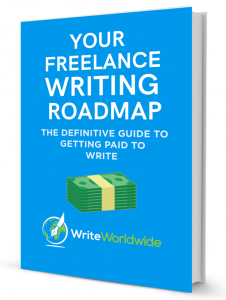
Wow!This is an awakening call for me. I have been using Linkedin for some time now, and secured actually good clients. However, I never thought of the strategies you have used here before. I will follow this procedure to secure more clients and avoid single source.
Hi Duncan,
So happy you found this post valuable. By all means, use the techniques we share here and share your results with us!
Keep well,
Nick
This.Is.Amazing!
“One where I started to focus more on the value of a project instead of the number of words and the time it takes to complete.” You know it very well, Nick!
I’ll start testing this and price my services based on value.
Hi Abass,
So glad you found it valuable. Yes, give it a try and share the results with us.
Keep well,
Nick
Great article, Nick.
I tried your methods but didn’t come up with any good results. Do I need to upgrade my LinkedIn account to a premium level before I can get the search results you got.
Thanks,
Nnamdi.
Hi Nnamdi,
Thanks for your comment.
The results I got were from a regular LinkedIn account, so no, you don’t have to upgrade your account.
You can’t expect instant results – it doesn’t work like that – sometimes you have to do some digging. In my case, the timing was just right and I found someone who was in the market for my services.
I’m curious, what search phrases did you use?
P.S. This is just one, among many ways to find clients. What other techniques are you using? Pick a few, stick with them, and if they don’t work, re-evaluate and change as needed.
Best,
Nick
Great post as always Nick.
I agree it’s a really bad (but tempting) idea to put all your writing eggs in one basket. Your re-visit to your business was spot on.
Getting the right number and mix of clients is a bit of a balancing act. Most writers can cope with about 3 regular clients (depending on work volumes from each), any more and they risk getting overwhelmed.
So, it begs the question “if you have enough clients, why should you keep marketing?”
Well, if you stick with marketing yourself regularly, eventually you’ll be able to:
– Work with the clients you enjoy most.
– Confidently ask existing clients for a better rate (can be difficult, but doable based on value).
– Talk confidently with new clients and ask for higher rates.
– Work less for the same money, or more for more money.
– Develop a steady, predictable income.
– Sleep soundly at night 🙂
I’ve had numerous $3,000/ mo clients but here’s the thing – they don’t last forever.
By continually marketing your business, even if a cornerstone client crashes and burns, you’ll still be able to afford pizza and cat food!
Best regards,
Les
Hi Les,
Thanks for the meaty comment 🙂 Yea I totally agree – getting the right mix is indeed a balancing act. I do prefer only having three regular clients at any given time as it allows me to focus and doesn’t cause overwhelm – like you say.
And, totally agree with your comments about why you should continue marketing. I’m actually in the process of creating a newsletter to improve my inbound marketing strategy. We’ll see how that goes. I’d love to sign you up if you’re game?
I’ll be publishing a monthly newsletter to start and will be providing content marketing and writing tips delivered to your inbox. While my market is content managers, marketing executives and content directors of B2B Tech companies, I believe adding friends and family to my list, is a superb way to help them understand what it is that you do. It also improves the chances of getting referrals 🙂
Again, thanks, and have a wonderful day.
Best,
Nick
Still taking notes…✍️ . Thanks for the amazing piece Nick.
Hi Irene,
You are very welcome! If you have any questions, feel free to reach out.
Best,
Nick